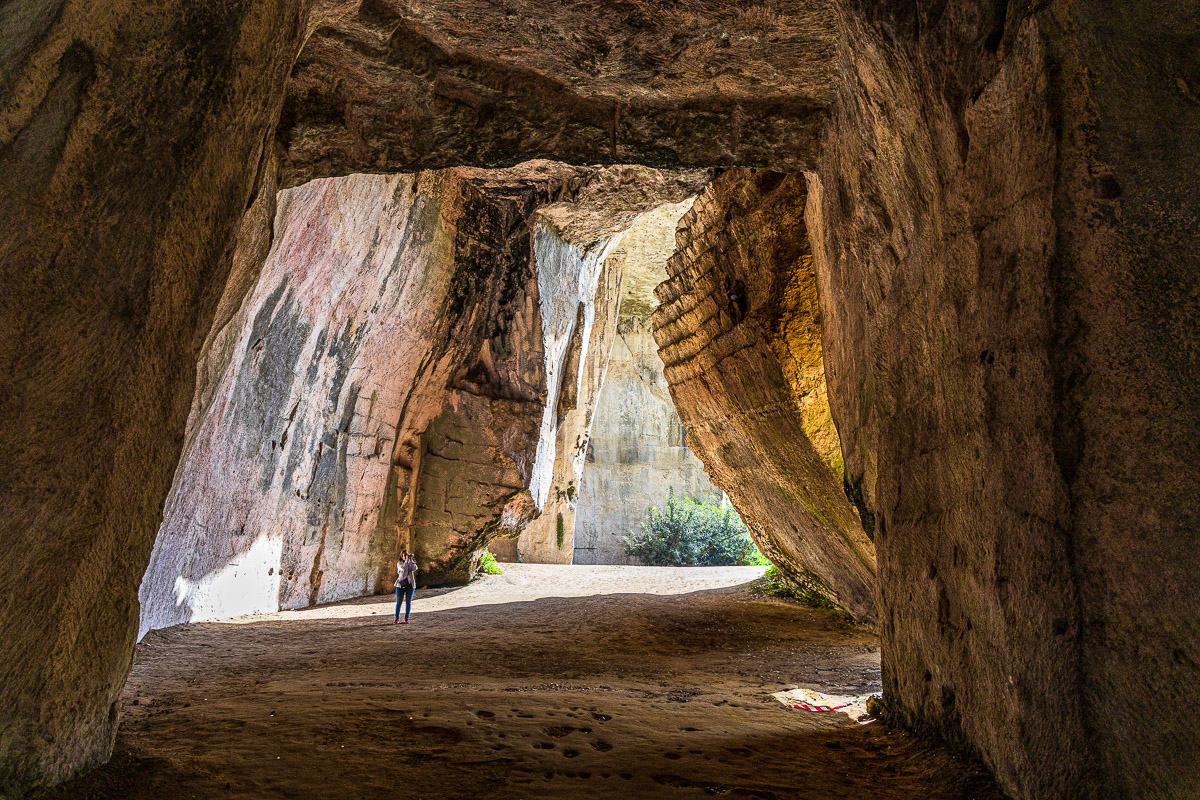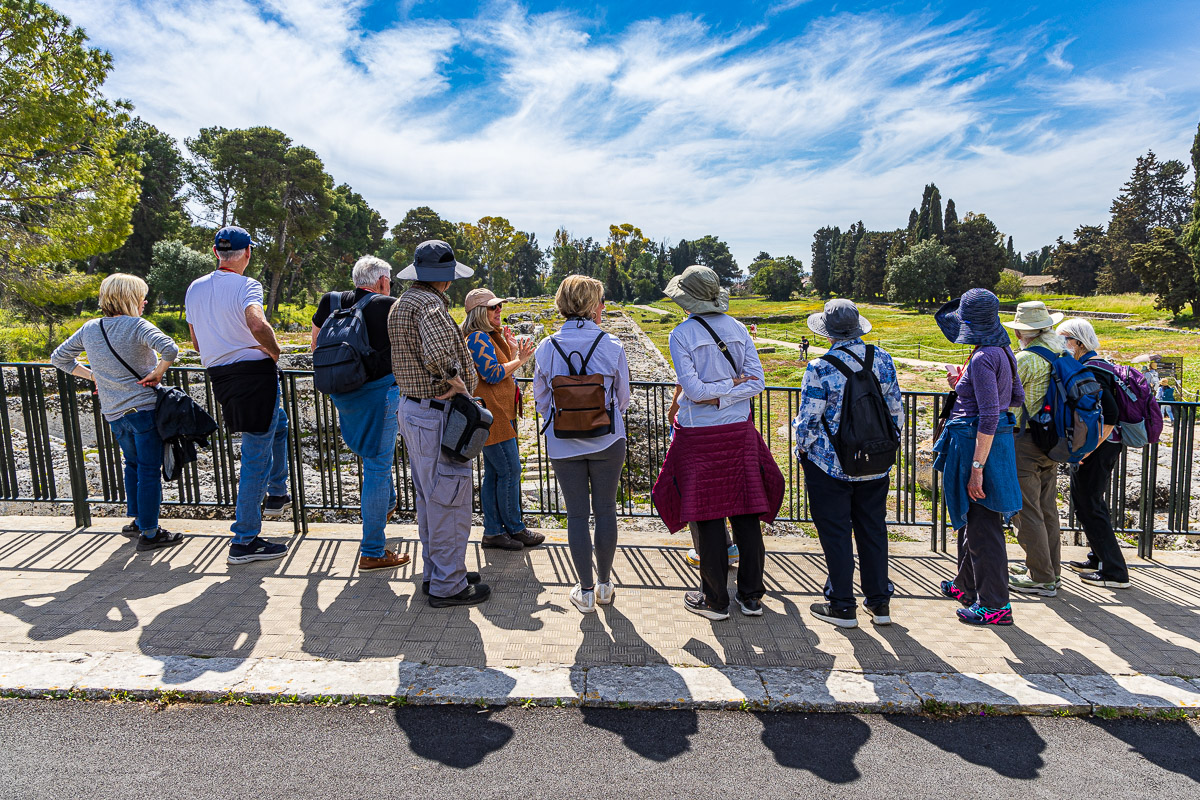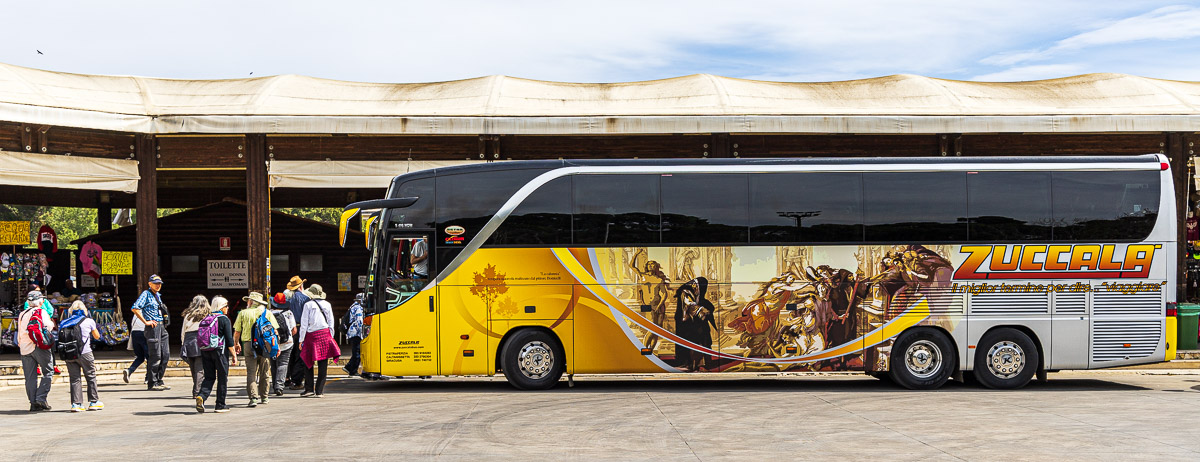In the fifth century BCE, Siracusa was the dominant military and economic power in the Greek world. The last of its remains now lies in the outskirts of modern Siracusa in the Neapolis Archeological Park. This is Siracusa’s greatest concentration of ruins. There you can find the Paradise Quarry, a Greek Theater and a Roman Amphitheater.

Paradise Quarry
Entering the Paradise Quarry, you’d think at first that you were in a park or a garden consisting of date palms, citrus trees, olive trees and other lush vegetation. This is not how it looked, of course, when limestone was being quarried in the sixth century BCE. At that time the lower quality surface rock was left in place while higher quality rock was removed from underground mines creating a large cavern.
The men who worked the quarry were enslaved prisoners of war who cut and carried the large blocks of stone used for construction of the city. Rick Steves called the quarry “a huge underground concentration camp, a hellish place where slaves lived out their miserable lives cutting stone.” The roof of the mine collapsed during the massive earthquake of 1693 and only one stone pillar that had supported the roof remains standing. Since nature abhors a vacuum, plants moved in and turned the prison into a paradise.
Mouse over the small photos in galleries to see captions.
Click on any one to enlarge, then use arrows to scroll through the rest of the images.
There are several sections of caves or rooms in the quarry. Walking through them you can see the scratches in the rock from the chisels used by the miners. In some places you can see a checkerboard of marks on the walls outlining where blocks of limestone had been removed. Water dripped from the rocks in some of the caves creating shallow pools on the floor. Ferns, moss and other small plants grew in this dim, wet environment. A century or two ago rope makers used these caves because their size gave them room to spread out the plant fibers and the natural humidity was helpful for twisting them into threads and ropes.
Farther along the quarry wall we came upon a narrow cavern that was 76 feet high, 214 feet deep, and only about 25 feet wide. This is the “Ear of Dionysius.” The name is due either to its ear-like shape or to its remarkable acoustics. We were encouraged to test out the acoustics by singing, but most people chose instead to clap. Since I had moved far enough from the others to take a photograph, I decided to sing a couple lines from a Beatle song by myself; the sound had a rather nice reverb. It would be interesting to play my guitar in there.
The Greek Theater
The Greek Theater was built in the fifth century BCE. Roughly 450 feet in diameter with 67 rows of seats, it was one of the largest in the Greek world. Like the one we visited in Taormina, this theater was carved out of the rock on a hillside. Having been abandoned for centuries, many of the original stone blocks were removed for construction elsewhere. The theater is being used again today for a limited number of performances. We could only view it from the hillside because it was being set up for the annual Greek Theater festival that runs from mid-May to mid-July. Since backsides today are not as rugged as they used to be, temporary wooden seats are being installed over the original rock seats.
Above the theater there is a broad terrace that was also excavated from the rock. It’s known as the Street of Tombs and consists of a series of artificial caves and niches cut into the limestone rock. The largest one is called the Cave of the Nymphs because at one time it contained three statues of nymphs. Though the statues are gone, the cave still contains a “waterfall” flowing from an aqueduct that carries water sourced in a spring about 15 miles away.
The final place we stopped in this section of the park was the Altar of Hieron II. If you weren’t already convinced that the Greeks did things in a big way, this monolithic 650-foot-long by 75-foot-wide rock structure would no-doubt convince you. It should come as no surprise that this is the largest known altar from antiquity. The altar was used once a year for a festival that featured the sacrifice of 450, yes 450, oxen. Only the base of the altar remains since, as with the theater, much of the stone had been removed for use elsewhere.

The Roman Amphitheater
The Roman Amphitheater was constructed in 21 BCE. It’s the largest such theater in Sicily. Although Greek theaters were typically a horseshoe or semicircular shape looking out over a scenic landscape, Roman theaters were like putting two horseshoe-shaped theaters together to create an oval something like we would think of a football field today. It should come as no surprise then that the word amphitheater comes from two Greek words meaning place for viewing and on both sides. (You learn something new every day.) Another difference is that the Greeks typically used their theaters for staging plays while the Romans used their amphitheaters for battles between gladiators and wild animals. After looking around on both sides and seeing no wild animals, we started to walk back to the bus.
When you have a driver, a guide and twenty tourists, you need a bus with ample room!

<— Back in Time in Buscemi (Sicily Part 5) :: (Sicily Part 7) In and Around Ortigia —>